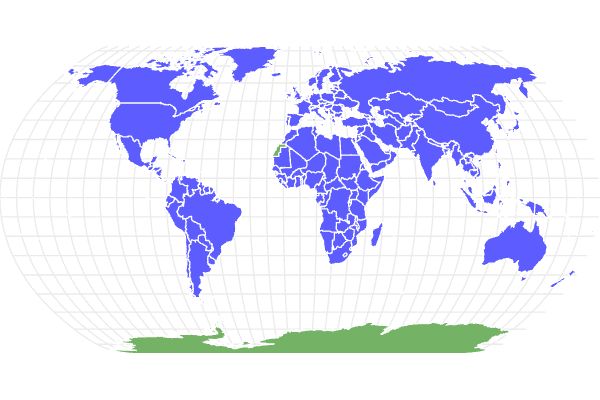Cow
Bos Taurus
There are nearly 1.5 billion worldwide!
Advertisement
Cow Scientific Classification
- Kingdom
- Animalia
- Phylum
- Chordata
- Class
- Mammalia
- Order
- Artiodactyla
- Family
- Bovidae
- Genus
- Bos
- Scientific Name
- Bos Taurus
Read our Complete Guide to Classification of Animals.
Cow Conservation Status
Cow Facts
- Main Prey
- Grass, Seeds, Flowers
- Distinctive Feature
- Thick leathery skin and complex digestive system
- Habitat
- Forest and grassland
- Predators
- Human, Bears, Wolves
- Diet
- Herbivore
- Average Litter Size
- 1
- Lifestyle
- Herd
- Favorite Food
- Grass
- Type
- Mammal
- Slogan
- There are nearly 1.5 billion worldwide!
“…roughly one cow for every seven humans on earth…”
Cows are animals that are found all over the world. They were domesticated by humans over 10,000 years ago for work, dairy, meat, and more. However, scientists are still learning much about their complex brains and emotions. These gentle giants range from 700 lbs, to as big as a car, with some having long horns, humps on their backs, colorful patterns, or other incredible traits! While technically a ‘cow’ only refers to a female, the term is often used to describe any animal of the species regardless of gender. The technically correct term for a group of animals in this species is ‘cattle’.
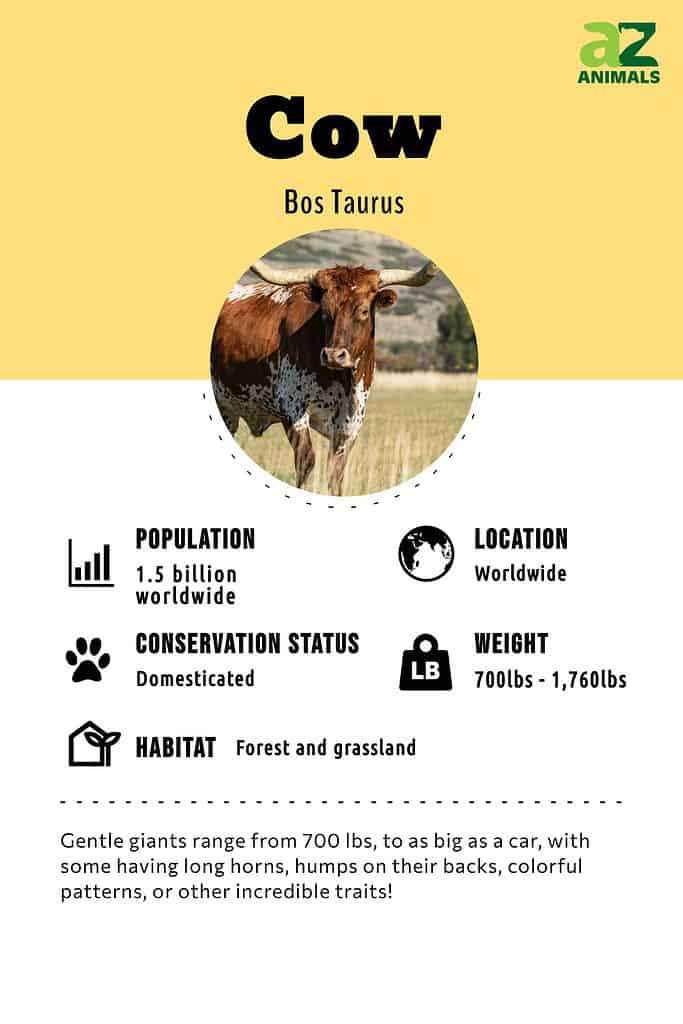
Cow Facts
- The largest cows grow to almost two tons, as big as a car!
- Cows are the second-largest type of livestock in the world, by number!
- A cow can produce over seven gallons of milk per day!
- Cows are sacred in parts of India and slaughtering a cow there is often banned.
Check out more incredible facts about cows.
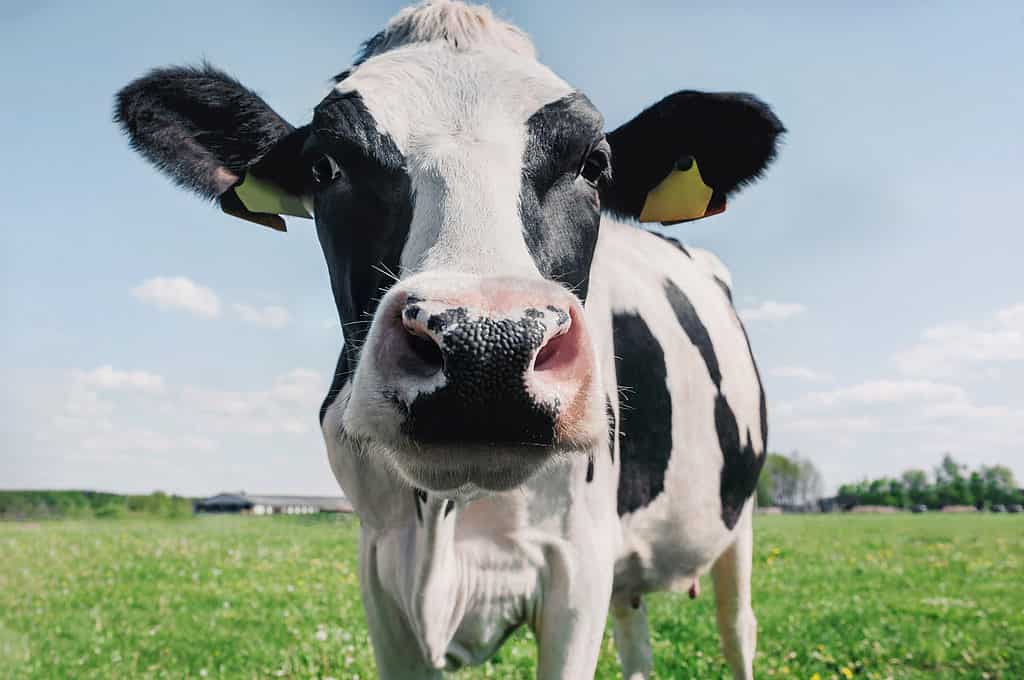
Cows are the second-largest type of livestock in the world, by number!
©Alena Demidyuk/Shutterstock.com
Scientific Name, History, and Evolution
The scientific name for a cow is Bos taurus. Bos Taurus is the largest in the category of bovinae. Two major subspecies of cow are the indicus and the taurus (or Bos taurus taurus). Indicus traces its roots to southern Asia, particularly modern-day India. Meanwhile, the taurus traces its origins to Europe.
The predecessor to modern-day cows was the auroch. The auroch was an undomesticated bovine that lived in what is now Turkey and Pakistan. As cows were domesticated, they were interbred and soon started to spread across different civilizations. Researchers have found that the genetics of cattle brought to the Americas during Spanish colonization have traces of serval different bovine lineages, showing the historical mixing of breeds from African cows and European cows.
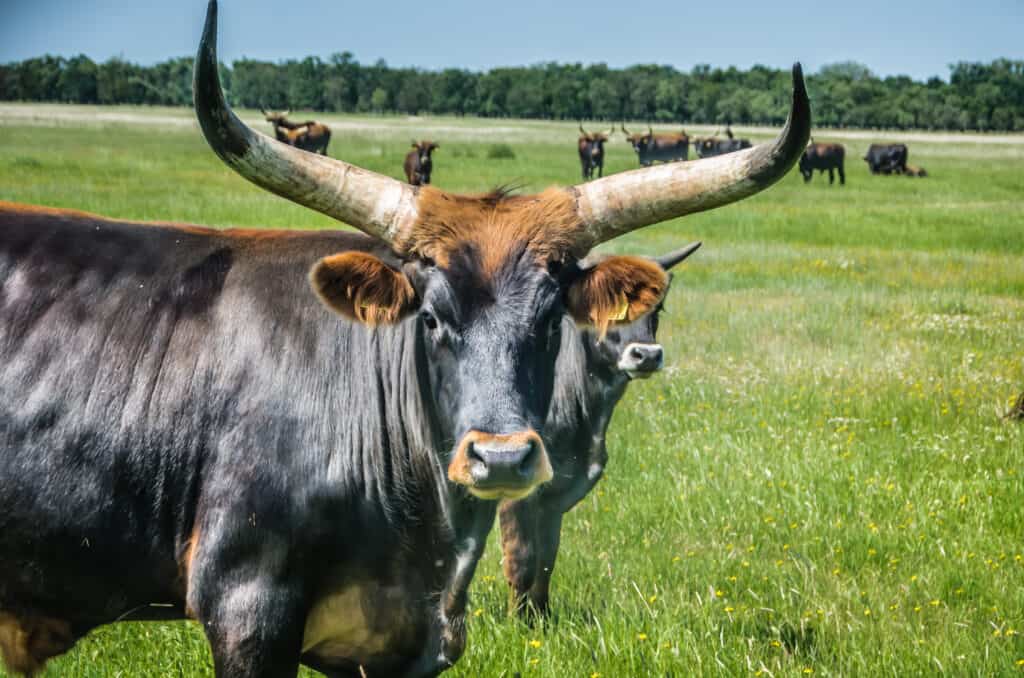
The predecessor to modern-day cows was the wild auroch.
©Tito Slack/Shutterstock.com
Appearance and Behavior
Cows are animals that come in a wide array of breeds, colors, sizes, and even shapes! Standing on four legs with hooved feet, the average adult cow weighs a little less than a small car–about 1,500 pounds. This varies depending on breed, ranging from the Chianina cow, which grows to over 3,700 pounds, to the Dexter cow, which tops out at about 750 pounds. These breeds stand six feet and three feet tall at the shoulder, respectively.
Most cows have a thin layer of bristly hair, but certain breeds have longer hair. These skin and hair combinations come with a number of distinct patterns. The holstein is the most well-known style, with irregular black and white shapes, with a strip of white between the eyes. A “red” holstein has brown or reddish brown patches in place of the black. Angus cows are black from head to tail. The Highland cow features long, shaggy, brownish-red hair. Though there are hundreds, if not thousands, of breeds with different markings, most feature variations on gray, brown, black, and white hides.
Indicus cows of any breed have another feature: a “hump.” This protrusion on the back of these cows’ necks is the easiest way to tell them from taurus cows.
Almost all cows have horns. These range in length and shape across breeds. Sticking almost straight out to the sides from its head and reaching roughly three feet long each, the horns on a Texas Longhorn cow are easy to spot. In fact, a Texas longhorn holds the Guinness World Record for cow horn length, measuring over ten feet long from one tip to another. Meanwhile, a Brahman cow has roughly six-inch-long horns that point up and back from its head. The English longhorn can have horns that point mostly downward, curving similarly to a sheep’s horns.
A group of cows is called a kine. And a group of cattle is a herd. Check out this article to learn more about group cow names and how they function.
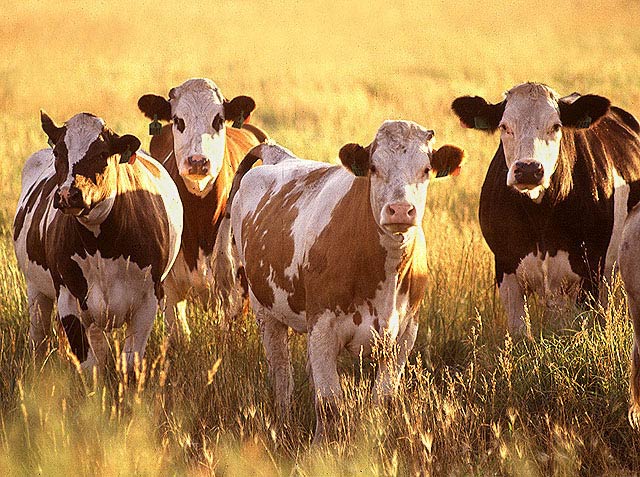
Types of Cows and Cattle
There are over 250 different types of cows throughout the globe, and American ranchers alone have around 80 breeds in which to access.
Here are some of the top cow breeds:
- Angus Cow – The Angus Cow, also known as “Aberdeen Angus”, is the most common beef cattle breed in the United States. There are more than 330,000 registered Black Angus cows. One reason the breed is so popular is the characteristics of its meat, which are marketed as yielding meat with a rich flavor and plenty of marbling. Another positive aspect of this breed is that they are pretty self-sufficient as calves. These cows are also great at being mothers as well.
- Belted Galloway Cow– The Belted Galloway Cow, also known as “Oreo Cattle”, is aptly named because of its white stripe surrounded by their black head and rump. While mostly sought out for their coloration, they do make quality beef that is lean.
- Brahman Cow – The Brahman Cow hails from India and is actually the world’s most numerous cow breed. They stand out because of their protruding hump over their shoulders. They also have extra skin under their throat area for warmth.
- Charolais – The Charolais Cow originally comes from France. They have a light-colored coat, and they are raised for drafting purposes, like fieldwork, but also for milk and beef. They are known for being hardy and withstanding cooler conditions.
- Dexter – The Dexter Cow hails from Ireland and is one of the smaller versions of the cow. They are valued because of their gentle nature and size which requires less acreage to manage. Furthermore, they provide the most milk per pound than other cattle breeds.
- English Longhorn – The English Longhorn Cattle is a multipurpose cattle breed that is known to be easy to raise and is in use as a work animal as well as beef and dairy. Also known as the British Longhorn. This breed’s origin is in Craven, England, during the 1700s, and was primarily in use as a draught animal (or a work animal). The breed is found nearly everywhere on the planet now and is known for its extended horns on both sides of its head.
- Fleckvieh – Fleckvieh Cattle serve a dual purpose and are raised for their meat and milk production. They became popular in the 19th century and originated in Austria, but now can be found all across Europe, the USA, and certain parts of South America. These cattle result from cross-breeding native stock with Simmental cattle native to Switzerland around the 1830s. Simmental cattle are known for producing top-quality milk and meat. In addition, they are highly immune to diseases, making them a desirable breed.
- Gelbvieh – The Gelbvieh Cow comes from Bavaria, Germany, and was used for all-around purposes. Via artificial insemination, they were incorporated into American cattle in the 1970s for their strong birthing and mothering qualities.
- Hereford – Hereford Cows can be found worldwide in a variety of climates, which makes them a popular breed. They are, after all, a highly adaptable breed of cow. In the U.S., Herefords were popular because they matured early and fattened well. It’s common to hear that Herefords are docile, easy to breed, milk well, and are also very dependable mothers.
- Holstein – Holstein Cows are black and white, and they probably come to mind when you think of stereotypical cows. This breed is known as the Holstein Friesian. The reason this breed is so popular is that it is often used in advertisements for dairy products. There is plenty of high-quality milk produced consistently by these cows. Because of this, they are generally kept as dairy cows in order to continue producing milk.
- Limousin – The Limousin Cow is an ancient breed of cow that can even be seen in prehistoric paintings on cave walls that date back tens of thousands of years. These cows come from France originally and have a reddish and golden hue to their hair. They now are plentiful in American and Canadian ranches.
- Lineback – Lineback Cattle are named after the line that goes down the middle of their back, the lineback cattle or Randall lineback cattle is a critically endangered rare breed of cattle that is currently being conserved in the United States to prevent extinction. Like most other cattle breeds, they are used for dairy and beef and are generally low maintenance. It is easy to spot lineback cattle due to the thick white line going down their back.
- Nelore – The Nelore Cattle breed descended from the Ongole cattle breed which was originally from India. Their main use is meat and milk production, as well as riding animals and draught. Nelore is a widespread breed, accounting for more than half of the world’s total bovine beef-producing population. This breed is not just sought after for its tasty beef, but also for its hardiness, resistance to extreme heat, insects, bloat, and prolific reproductive life as well.
- Nguni – Nguni Cattle are native to the Southern region of Africa. They are widely known and revered for their eye-catching speckled and multi-patterned hides. This cattle breed is also known for its good temperament and ability to withstand harsh climate conditions. Nguni cattle originated as a hybrid of various Indian and European breeds. They are sought after for their excellent natural immunity to tick-borne diseases.
- Piedmontese – The Piedmontese Cow are well known for their exceptional muscular genetics. They build muscle mass faster than other breeds. They are also hardy and resistant to many diseases. They orgininated thousands and thousands of years ago in Italy and were the product from breeding two ancient types of cattle: the Pakistani Zebu and the European Auroch. They have since been incorporated on American ranches and are an important source for many cheeses from Italy.
- Red Angus – The Red Angus Cow is originally a Scottish breed and a product from red English longhorns being bred with black Angus cows. The goal was to create work animals. Only a few of the resulting offspring were red. Eventually American ranchers saught to breed red offspring together in order to strengthen the Red Angus breed into what it is today.
- Scottish Highland – The Scottish Highland Cow originally hails from the high elevations of the scenic Scottish Highlands, this breed is now raised worldwide for meat production. Judging by its behavior and physical characteristics, it is very much a quintessential cattle breed. But the Highland cattle also has many distinct features, including its sturdy constitution and incredibly long hair.
- Shorthorn – The Shorthorn Cow comes from the Brittish Isles and is also known as Durham cattle. This was a popular breed for early American settlers because they are known to be very manageable, long-lived, and easy to breed. All of those qualities help them become the cattle of choice for early Americans who needed cows as work animals and for dairy and meat production. Some are naturally polled, and some are horned.
- Simmental – The Simmental Cow. Among all breeds of cattle, the Simmental is one of the oldest and most widely distributed. American beef farmers have been benefitting from the introduction of these red and white cattle since the late 19th century. Having a large body frame, they require little help during calving season and can gain weight quickly.
- Senepol – The Senepol Cow is a specially created breed from St. Croix, one of the U.S. Virgin Islands. Breeders created them by selectively breeding N’Dama cattle from Senegal and the British red poll cattle from the island. It is no difficult task to identify these animals. Their unique red color and lack of horns, among many other desirable, qualities. Breeders rear Senepol cattle for their top-notch milk and meat production. They happen to be one of the most sought-after cattle breeds.
- Texas Longhorn – The Texas Longhorn is one of the most iconic animals in America. These mammoths developed to be hardy, rugged, and parasite and disease-resistant in the American West being able to sustain themselves on rougher plant life than many other breeds of cattle. Through overzealous crossbreeding, they were almost wiped out by ranchers around the turn of the 20th century, but the longhorn population has since recovered.
- Watusi – The Watusi Cow, known as “African Ankole-Watusi”, comes from the Nile Valley and dates back its roots over 5,000 years ago. These are known for their strikingly large horns and can be seen on ancient drawings from Egypt. Naturally, the Watusi breed can thrive in warm environments, and their horns actually aid the cattle by cooling down their blood through increased circulation.
- Welsh Black – Welsh Black is one of the oldest breeds in the United Kingdom and existed in pre-Roman Britain. For approximately 1,000 years, Welsh black cattle have been bred in Britain and Wales for dairy and beef production. There were two main types of this breed: the Northern, known for their beef, and the Southern, known for dairy. Welsh black cattle, as they are known today, are a combination of the Northern and Southern breeds and are best suited for beef production.
- Wagyu – The most valuable cattle today is probably the Wagyu Cattle. Their beef has a unique taste and unparalleled marbling content. It is sought after in hihg-end restaurants around the world. There are four types of Wagyu breeds: Japanese polled, Japanese shorthorn, Japanese brown, and finally Japanese black being the most common in Japan.What Do Wagyu Cows Eat? 15+ Foods They Consume
Intellect and Emotion
Recent research has found that cows are really smart, complex animals! They can learn, have memories, figure things out, and can even tell one cow from another. They have personalities too, with scientists documenting cows who are bold, shy, playful, and other traits.
Cows also show emotion. When they’re scared or anxious one can see more of the whites of their eyes, such as when a mother is separated from her calf. In addition, their ears will hang more loosely when they’re feeling o.k. Their mood can also be affected by the mood of other cows, what scientists call “emotional contagion.” For example, a cow might eat less or act more anxious, simply because other cows in the herd are scared or hurt.

The mood of cows can be affected by the mood of other cows, which scientists call “emotional contagion.”
©iStock.com/Goldfinch4ever
Habitat
Cows are animals that can survive in many climates and places. The indicus subspecies are better suited to tropical environments, while taurus cows can survive easily in winter climates. In general, cows need access to a wide range of space, so they can graze on grasses. Whether in the mountains, jungle, or wide open plains, cows can adapt to many different environments.
Diet
Cows are herbivores, which means they eat grass and other plants. Cows can eat a wide range of tough grasses thanks to their very unique way of eating. A cow will first bite plants or grass and swallow them unchewed. This unchewed food goes into its first stomach until later. When the cow finds a quiet place, it will begin to vomit the plants back into its mouth. This vomit is called “cud,” and the cow will chew the cud down into smaller pieces for further digestion.
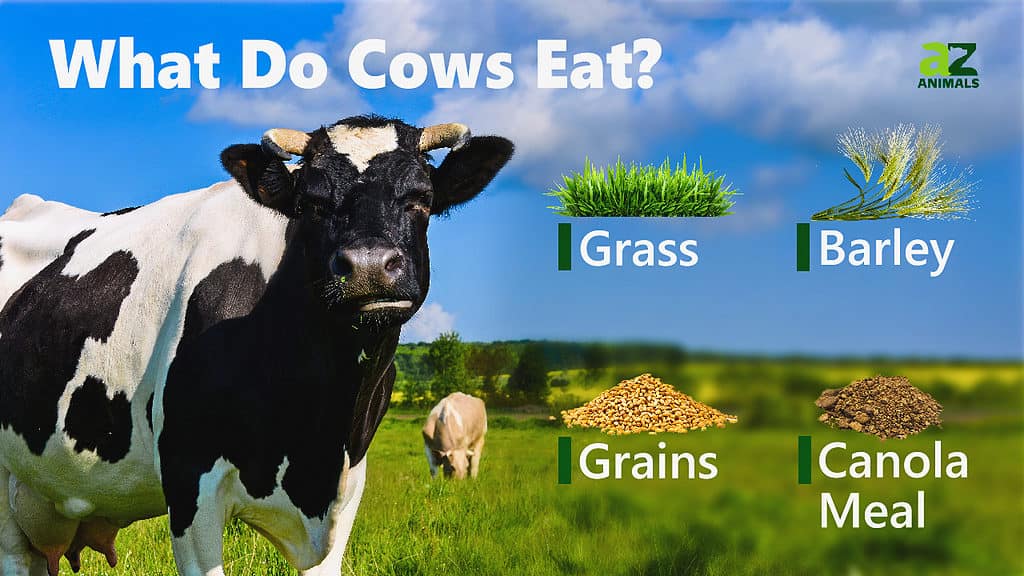
Predators and Threats
Cow predators include dogs, coyotes, bobcats, and similar animals. Because most cows are on farms, the threat of predators is typically small. In the United States, for example, only two percent of all farm cow deaths were the result of predators. Most of those predators were dogs, followed by coyotes.
The bigger threat to cows comes from disease. Because cows move in herds, one sick cow can quickly infect others. Depending on the type of infection, this can cause big problems. For example, some worry about a return of Foot and Mouth Disease (FMD). FMD doesn’t affect humans but can wreak havoc on cows. FMD is spread easily for miles, and can quickly infect a whole herd.
Governments take cow diseases very seriously. In 2003, reports that some U.S. cattle were infected with a disease called “mad cow disease” resulted in governments not allowing U.S. beef in their countries. This costs beef farmers roughly $11 billion in lost sales.
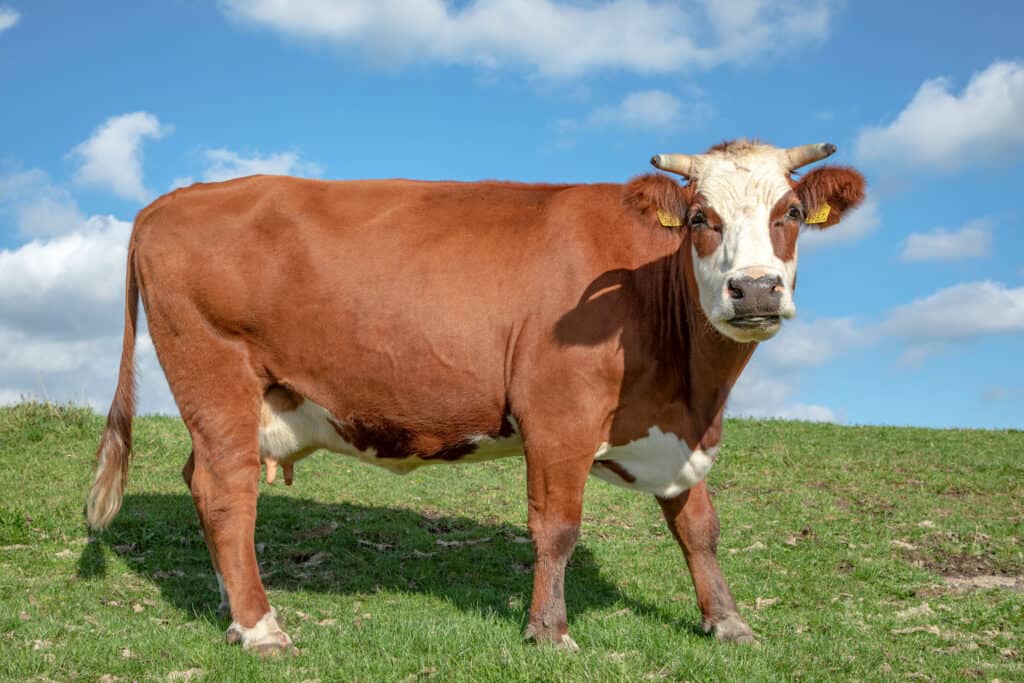
Fleckvieh cattle are typically social animals that live in herds. The reasons behind this behavior is protection from predators and working together to find water and food.
©Clara Bastian/Shutterstock.com
Reproduction, Babies, and Lifespan
Cows begin their life after a nine-month pregnancy. Following a live birth, the baby, known as a calf, will nurse for a few months before weaning. The baby can typically walk shortly after birth. It will take about one to two years for a cow to grow to the point that it can start having babies of its own. Cows typically have one baby at a time.
Most farm cows are bred artificially–that is, a sperm is implanted in the cow. This helps farmers to avoid certain genetic problems.
As an adult, a cow will give birth to a single calf once every two years or so. Though the natural lifespan of a cow can go over twenty years, most cows don’t live too much beyond ten years. This is because the majority of cows are part of a farming operation, and after a few years of milk production, cows are typically then tagged for meat processing.
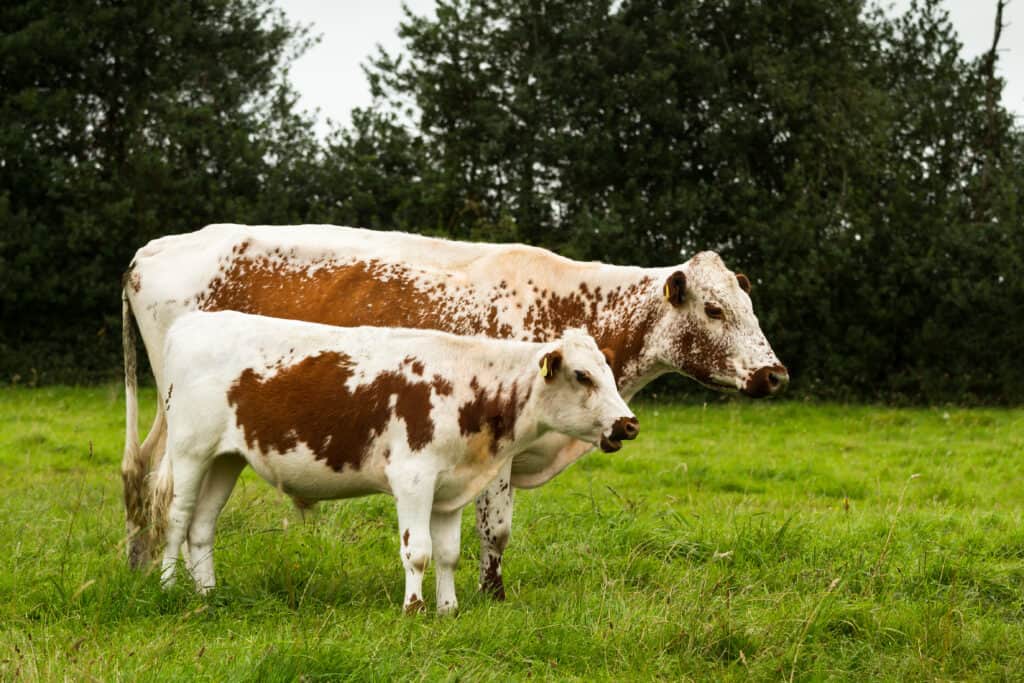
The baby calf can typically walk shortly after birth, and it will take about one to two years for a cow to grow to the point that it can start having babies of its own
©Jane Stanley/Shutterstock.com
Population
Numbering over 1.4 billion, there’s roughly one cow for every seven humans on earth. This makes cows and cattle the second most abundant farm animal in the world. Though there are select areas of wild cows, the majority of bos taurus are domesticated. This means they were raised to live on a farm.
Though cows in general are not at risk, certain breeds are significantly less common than others. Various conservation groups work to retain rare breeds of cows, such as the Dexter.
View all 235 animals that start with CCow FAQs (Frequently Asked Questions)
What is the difference between bison and cows?
The main difference between bison and cows is their size. Bison have a large hump on their back, massive heads, and a neck that blends in with their bodies. By contrast, cows are smaller and have a much more distinct neck and wider midsection.
What's the difference between buffalos and cows?
The coloration, size, and horns of buffalos and cows are all very different. Buffalos are larger and taller than cows and have long horns that grow horizontally from the sides of their heads.
Are cows female?
Technically, a “cow” is a female that has given birth at least once. Prior to giving birth, the cow is called a “heifer.” Many people also use the term “cow” when talking about either male or female cattle. Cattle, however, is the common term for any member of the herd.
What is the purpose of a cow?
Throughout most of the world, cows are used for milk. After a cow gives birth, farmers let it nurse the baby calf with the special milk, called colostrum, for the one or two months it is produced. After that, the cow will then spend roughly 10 months producing around seven gallons of regular milk every day.
How many stomachs does a cow have?
A cow has four separate stomachs. The first two stomachs store largely unchewed food, while a cow waits for a better time. When it has the time, a cow will more thoroughly chew food from these stomachs, called “cud,” before swallowing it into one of the two other stomachs to finish digestion.
Where do cows come from?
Cows were domesticated as far back as 10,000 years ago from an animal called the Auroch. Aurochs were roughly twice the size of a modern cow, and are extinct today. The Aurochs domesticated from southern Asia became the bos taurus indicus subspecies of cow, while the Aurochs domesticated from Europe became bos taurus taurus subspecies.
Are Cows herbivores, carnivores, or omnivores?
Cows are Herbivores, meaning they eat plants.
What Kingdom do Cows belong to?
Cows belong to the Kingdom Animalia.
What phylum do Cows belong to?
Cows belong to the phylum Chordata.
What class do Cows belong to?
Cows belong to the class Mammalia.
What family do Cows belong to?
Cows belong to the family Bovidae.
What order do Cows belong to?
Cows belong to the order Artiodactyla.
What genus do Cows belong to?
Cows belong to the genus Bos.
In what type of habitat do Cows live?
Cows live in forests and grasslands.
What is the main prey for Cows?
Cows prey on grass, seeds, and flowers.
What are some distinguishing features of Cows?
Cows have thick leathery skin and complex digestive systems.
What are some predators of Cows?
Predators of Cows include humans, bears, and wolves.
What is the average litter size for a Cow?
The average litter size for a Cow is 1.
What is an interesting fact about Cows?
There are nearly 1.5 million Cows worldwide!
What is the scientific name for the Cow?
The scientific name for the Cow is Bos Taurus.
What is the lifespan of a Cow?
Cows can live for 12 to 20 years.
How fast is a Cow?
A Cow can travel at speeds of up to 25 miles per hour.
Bull Vs Cow: Main differences
The key differences between a bull and a cow are their sex, size, and morphology. Bulls are mature male bovines while cows are mature female bovines that have birthed at least one calf. Also, bulls are larger than cows because cattle are sexually dimorphic. Bulls have a lot more muscle mass and thicker bones, so they’re larger in terms of height and weight.
Heifer Vs Cow: What are the differences?
The main difference between heifers and cows is: Heifers are mature female cattle that have not given birth to any calves, baby cows. The term cow specifically refers to adult female cattle that have had calves at some point in their lives.
Steer vs Cow: What are the main differences?
The greatest differences between a steer and a cow are their sex, purpose, and morphology. Steers are male bovines that have reached maturity after they have been castrated, whereas cows are mature female bovines. Steers are raised to be slaughtered for meat, and cows are also raised for slaughter, to produce more calves, and produce milk.
Ox Vs Cow: Main differences
The greatest differences between an ox and a cow lie in their sex, purpose, and age. Oxen are males in the vast majority of cases, but female oxen can exist if the owner needs a work animal but does not have a male available. Cows are female by definition, and there is no wiggle room on that terminology. Oxen are trained from a very young age to be draft animals, and they are solely raised to do work. Cows are raised to birth calves, produce milk, and be slaughtered for meat.
What are the key differences between goat milk and cow milk?
The key differences between goat milk and cow milk are the nutrition they provide and the common allergies and restrictions.
What is the difference between an Auroch and a Cow?
The main difference between an auroch and a cow is that aurochs are extinct and the ancient ancestors of a cow, while modern cattle have spread all over the world and are extremely prevalent.
How to say Cow in ...
Thank you for reading! Have some feedback for us? Contact the AZ Animals editorial team.
Sources
- David Burnie, Dorling Kindersley (2011) Animal, The Definitive Visual Guide To The World's Wildlife
- Tom Jackson, Lorenz Books (2007) The World Encyclopedia Of Animals
- David Burnie, Kingfisher (2011) The Kingfisher Animal Encyclopedia
- Richard Mackay, University of California Press (2009) The Atlas Of Endangered Species
- David Burnie, Dorling Kindersley (2008) Illustrated Encyclopedia Of Animals
- Dorling Kindersley (2006) Dorling Kindersley Encyclopedia Of Animals
- David W. Macdonald, Oxford University Press (2010) The Encyclopedia Of Mammals

